A month or so ago, a grand plan formed in my mind. Inspired by “Operation Crossfire“, I’m hoping to organise an event this autumn where lots of separate games are played simultaneously as part of a single campaign. As many games as possible will be organised to occur on that day in remote locations. There is a single overall commander for each side, and the players can contact them, in real time (via a website), to report on their progress and to request reinforcements or support. The commanders will have to balance the various objectives and the progress reports that they are getting and commit their limited reserves to assist whichever battle seems the most important. As the scenario progresses, models may move off one table and move on to a different table somewhere else.
Do please contact me if you are interested in playing in this (post a comment here or on the Oldhammer forum).
The scenario I’m working up is the infamous attack on New Rynn City, where a small number of Crimson Fist marines and Planetary Defence Forces desperately attempt to hold off hordes of Ork attackers. This battle was fought as a playtest – partly to see exactly how long it took, partly to see just how much the odds needed to favour the attackers and partly to try out some support fire rules.
So lets see what happened…
The curtain rises as a motley bunch of orks creep through the lush tropical vegetation that abounds on Rynn’s World. A highway runs up the middle of the table (I didn’t have any tarmac, so you’ll have to use a bit of imagination). It’s littered with craters and burning vehicles, victims of a strafing attack by an Ork gunship.
Facing them at the entrance to the city are two 5 man squads of marines, dug in behind improvised barricades. Rynn’s world is a primitive agri-world with basic stone buildings rather than towering metal skyscrapers.
“Sergeant, I don’t believe it, some of those orks aren’t even painted”. The grizzled veteran shook his head. “Is there no limit to the barbarity of these alien scum?”
My space ork collection is not exactly extensive. There are a few painted gems but here I’ve had to make up the numbers with completely unpainted ones, and also some Space Crusade ones, and being completely fair to these early plastics, are crude and unappealing sculpts.
Bit of an unexpected development at this point, as a party of marines came out through the main gate and headed up the highway. Clearly “knowing no fear” has an influence on their tactics, or perhaps they are hoping to make friends. Also another half squad came in by the sand bags.
Most of the orks headed for an industrial building surrounded by high walls, which offered an opportunity to get near to the city without being exposed to marine missile launcher fire. Others, including a missile launcher ork took up positions behind the burned out vehicles and prepared to give covering fire.
On the opposite side of the highway to the compound was a large cornfield. The advance party of marines headed for this, but two of them were cut down by some incredibly lucky skilled heavy bolter fire from an ork at the corner of the compound. (You try killing more than one model with the old Following Fire rules). So far, so good, for the orks. They jeered and waved their weapons “Hur, hur, itz gonna be easy to mash up these humies”.
The orks rushed through the compound, taking up positions behind the wall.
Threatened by outflanking with more orks in front, the marines torched the cornfield. It’s not in the rules, but I’m pretty sure that a field of ripe crops would be pretty easy to set light to. We ruled that it would block LOS and any model walking through it would take an automatic S2 hit each turn.
Meanwhile the Orks were lining up behind the compound wall. The marines were just out of bolter range, so all they had to do was climb over the wall, rush across open ground and gun them down where they were cowering in their heavily emplaced positions.
Can anyone guess what happened next?
With hindsight, yes it was a bit reckless, but these were orks, they’d just killed a couple of marines, and the clock was ticking – their mates were relying on them to bust a hole in the marine defences, so they weren’t going to hang around behind a wall waiting for the marines to die of old age.
It seemed worth a go and they were more of them than the enemy, so over they went. A couple of orks with heavy bolters stayed behind the wall giving covering fire. Note the marines sneaking up behind the cars.
Over they went, bolters blazing. The marines in hard cover returned a lethal volley of fire, cutting down about half the orks in a single turn. The chastened survivors climbed hastily back over the wall. At this point disaster struck again. A single ork with a bolter had been keeping an eye on the marines behind the car while the frontal assault was in progress. Seizing their chance, the marines went in and fried both ork heavy bolters to a crisp.
The furious orks returned fire and killed one marine (which considering everyone was in the open was a bit unimpressive).
Over on the other side, a squad of orks that has crept down the side of the burning cornfield makes a break for it.
The two marines by the cars were now surrounded by orks and taking fire from all sides. They decided their only chance was to run for the safety of the barricades – it was a fateful mistake, and less than half way back they were shot down.
It was now about two hours into the game, and it was time to go back to real life. After a two week break (yes, really), we got a chance to finish the battle.
The orks’ problem at this point was a sheer lack of numbers. Although they had killed a 5 man squad’s worth of marines, the marines had received reinforcements and were back up to 15, including two missile launchers. To push the attack home across the almost completely open ground in front of the marines’ entrenchments really needed a 2 or 3 to 1 advantage, whereas actually they were about even numbers. Their only heavy weapon was a missile launcher who was lurking around at the back taking ineffective potshots at the marines. A stalemate had developed.
Things were about to get interesting, because this time we had support rules. Lacking the environment of a larger series of battles, we set a series of 15 minute intervals as alarms on a phone. Each time the alarm went off, whatever point in the turn it was, we wrote down what we wanted next time, and applied last time’s request. You could request artillery, an air strike or a new squad, needing a roll between 3+ and 5+ depending on what it was and which side you were on.
We rejoin the battle just before the first arrival of support. The marines have a strong hunch that something nasty is about to land on them, and have executed a brisk double move away from the barricades. We wrote down the co-ordinates (in inches) of where we wanted the fire, and I had requested artillery for (20, 20), which turned out to be the exact centre of the toll booth hut. It automatically deviated 2d6, which in this case took it neatly into the centre of the adjoining position.
As everything within 6″ would have taken a S5 hit, it would have been devastating if they had still been there. Even being within 12″ they run the risk of shrapnel, but none are killed.
The marines call in support of their own but to little effect. Their next call is for reinforcements (5+ required) which they get – the marines arriving to plug the hold on their left flank.
The use of support fire is certainly disrupting the marines cosy digging in, with even the threat of it making them manoeuvre. The orks bring in an air strike but with relatively little effect. Air strikes hit a 12″ strip between two requested co-ordinates, each automatically deviating 3d6″. Models within this area are hit on a base 4+ with a S4 hit. At this point, the marines’ position was really looking very good. They had approximately equal numbers and were still well dug in. There was about 1.5 hours left, and although the orks were relatively close, they still had a long way to go. We thought that if this had been the campaign game at this point the marines might have released a few troops to go to another battlefield.
The marines managed to bring in an air strike a little off target but well placed enough to hit almost every ork on the battlefield. However, few were hit and only a couple were killed. Ork toughness was a real asset to keeping them in the fight.
As the two forces were less than 24″ apart, the support fire was becoming a danger to the other side. In the next air strike it came in slightly skewed and a marine was caught by his own fire.
The orks were pressing hard. One squad had crept forward (using the hiding rules) from the compound to take up positions behind a hedge – just close enough to use their bolters. The others crouched behind a large bramble bush. The three marines nearest to them had been driven round the corner of the hut by the threat of the ork missile launcher who was still taking potshots from the back.
The bramble bush squad rushed forwards – one lot of marines were hiding, the others were occupied in a firefight with the orks behind the hedge. They reached safety behind the hut. I was starting to worry at this point – not expecting to have advanced so far, I had called in artillery on this hut 15 minutes ago and there was now a very real risk it could land smack on top of my own orks. To my immense relief, it deviated a little away from the hut, but near enough to catch all three marines in the blast, killing two. No orks were harmed in spite of two being in range of the shrapnel.
With the orks surrounding the hut, it is short work to gun down the surviving marine, leaving them free to take control. The reinforcing squad of marines rush forward in an attempt to salvage the situation with a flamer blast.
Unfortunately for them the orks are a bit more capable once shooting at short range at targets in the open, and only the rear marine survives. From the shelter of a stone shed the last two squad members pour in fire.
With a dangerous breach developing in their line, the surviving marines move down in attempt to seal it off. Fortunately the orks they had been facing behind the hedge have been killed by a combination of small arms fire and a strafing run. One marine missile launcher has already been killed, and the other is still behind the sandbags.
The marines finally have a bit of luck at the hut when a shell lands right on top of the attacking squad, killing all but one of them. It wasn’t even correctly targeted, it just deviated on to them. The marine is also killed in the blast, but with 5 orks facing him, his chances were pretty limited anyway.
The marines are now down to the two by the stone shed, and a missile launcher behind the sandbags on the other side of the gate. They are facing a lone ork at the hut, and another fresh squad which has been making its way down the highway for the last half hour.
The marine missile launcher is hit by the ork heavy bolter, but saves – his return shot with a krak missile is right on target.
Back at the hut the lone ork tries to gun down a marine at point blank range and misses with a 1. He survives the return fire, only to roll yet another 1. Pathetic effort, but help is close at hand.
The orks take cover behind the sandbags and a volley of bolter fire dispatches the two marines.
The turns are coming so fast now that there is no time for supporting fire. Less than 20 minutes remain on the clock, but the orks close in on the surviving missile launcher as he hides behind the toll booth. A few minutes later and it’s all over. The four orks are left in sole possession of the battlefield, and the way into the city is open.
All in all it was a good fast paced battle. It was very small – 15 marines reinforced by a further 10, with 20 orks reinforced by a further 10 on the other side, but your sense of importance becomes scaled to fit. A simple 5 ork squad charging up the table at the end of the game became a formidable force. The supporting fire greatly spiced it up. It was potentially very powerful, but the need to select and book it 15 minutes in advance, only to risk it not turning up at all or deviating on to your own troops meant that you couldn’t ignore the ground war and just sit back and wait for the artillery to do the job for you.

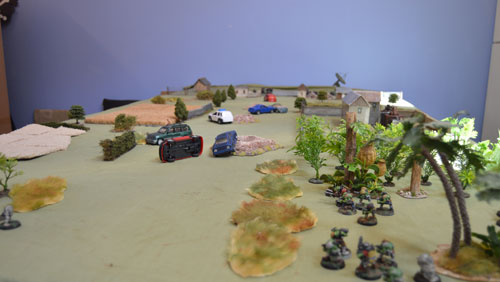
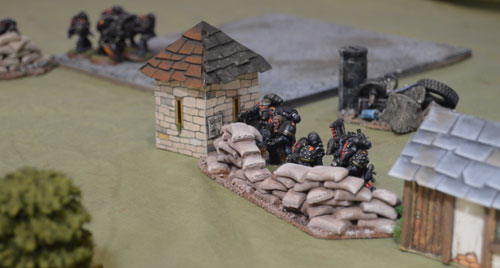
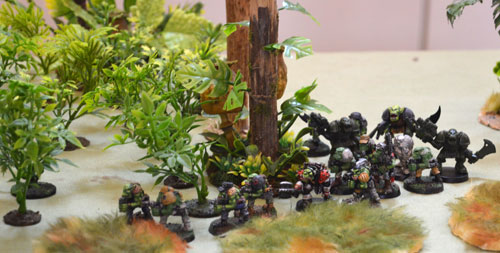
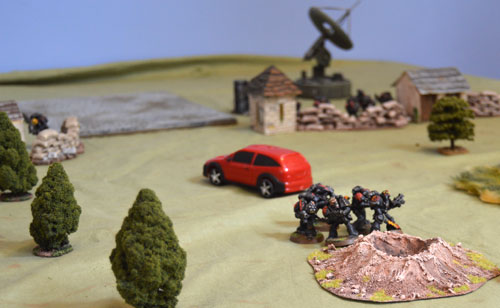
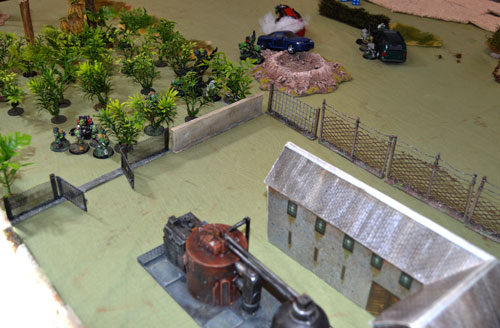
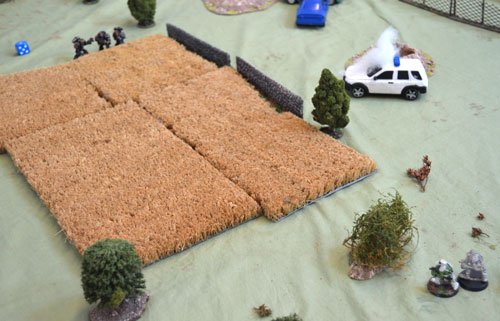
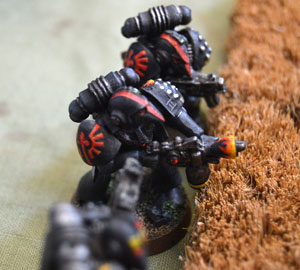
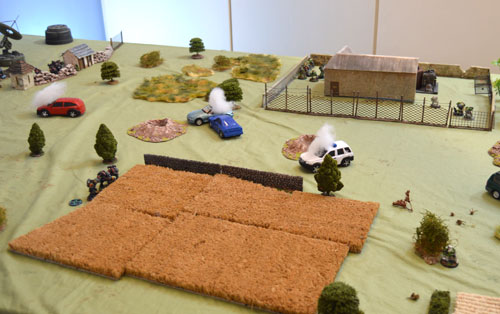
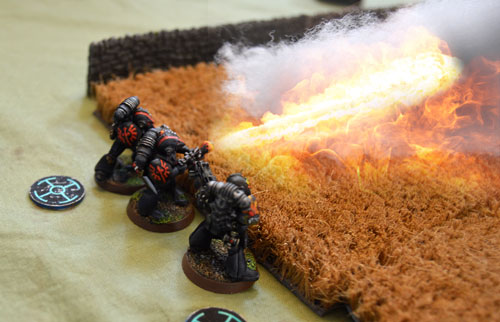
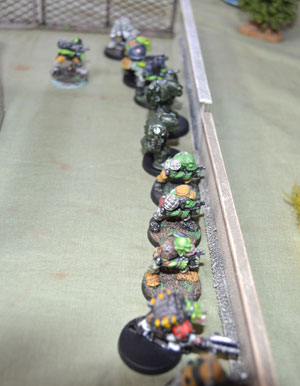
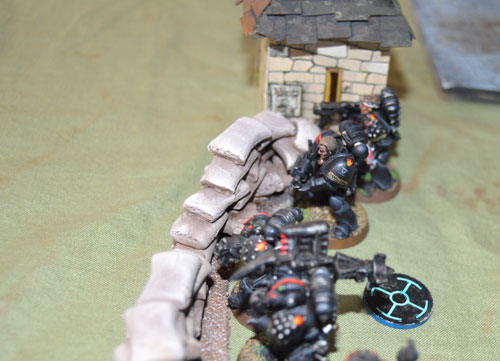
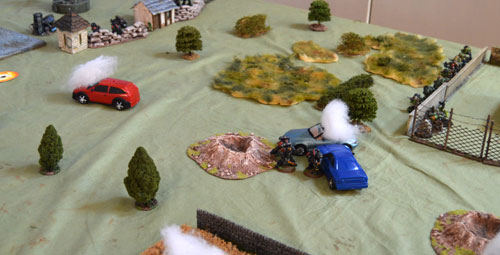
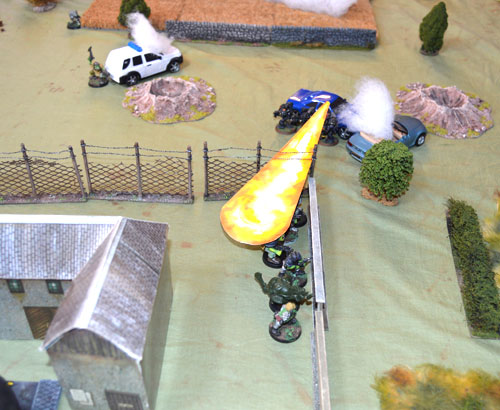
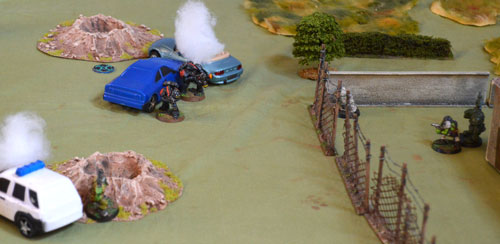
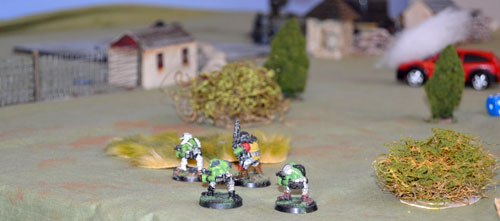
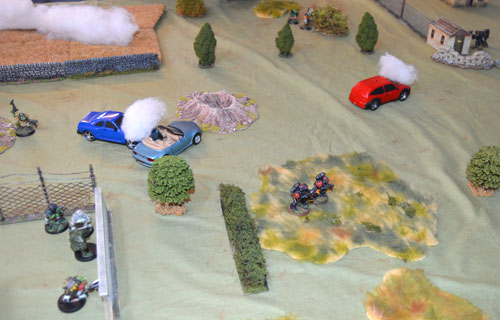
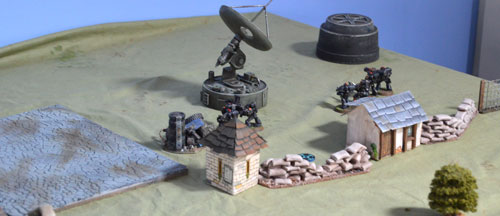
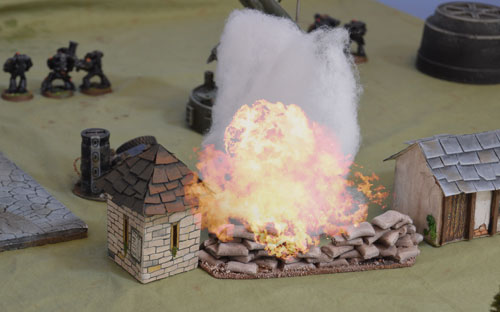
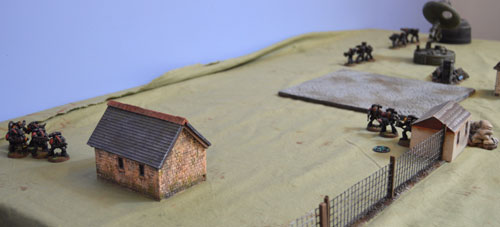
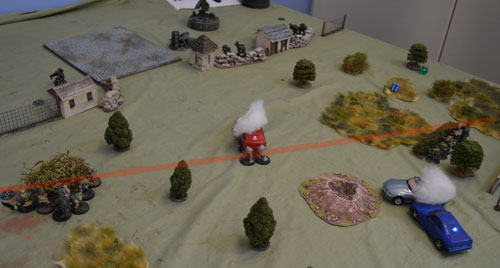
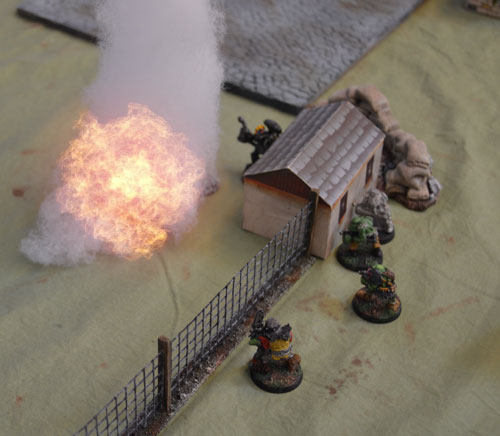
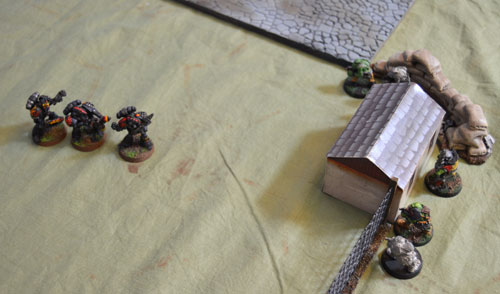
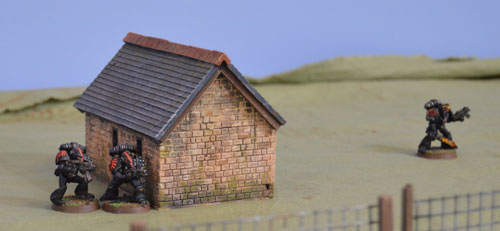
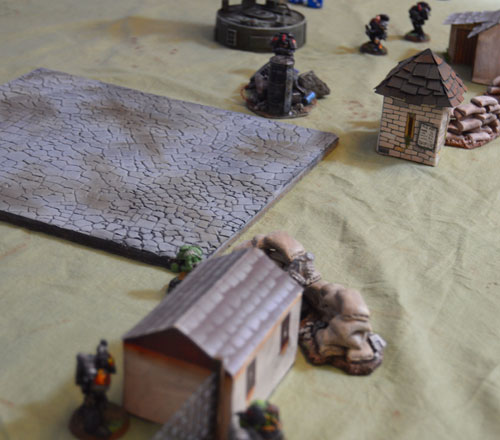
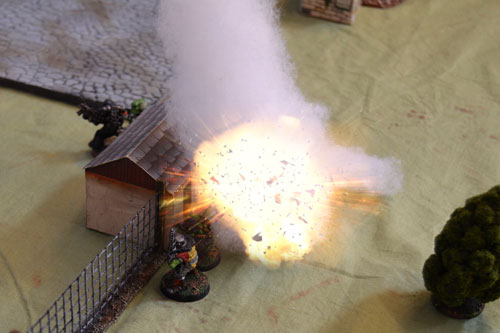
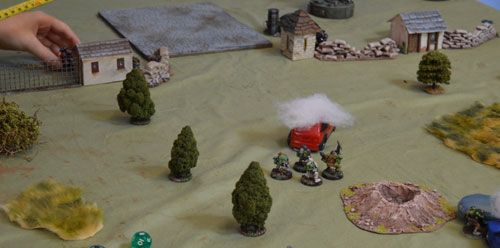
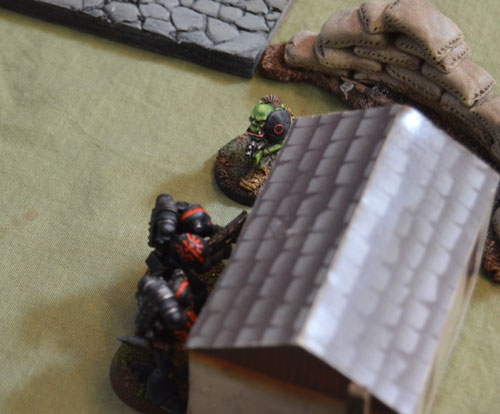
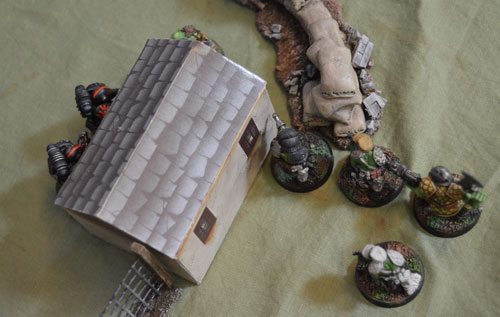

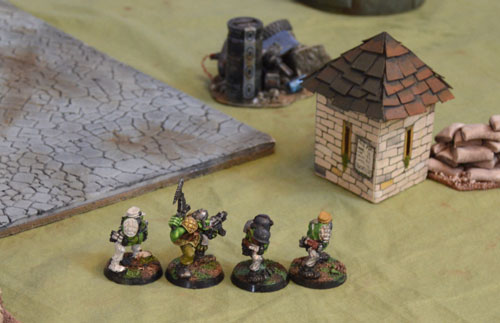

Leave a Reply